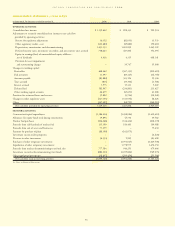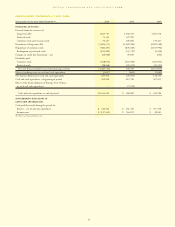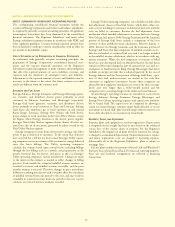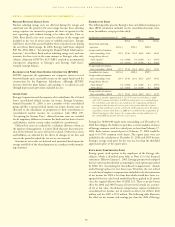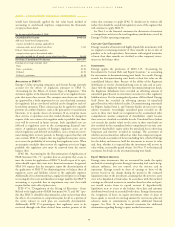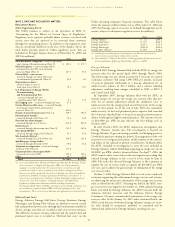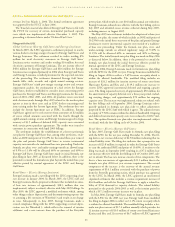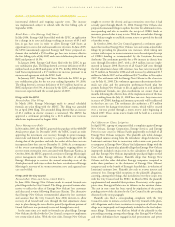Entergy 2006 Annual Report Download - page 77
Download and view the complete annual report
Please find page 77 of the 2006 Entergy annual report below. You can navigate through the pages in the report by either clicking on the pages listed below, or by using the keyword search tool below to find specific information within the annual report.
ENTERGY CORPORATION AND SUBSIDIARIES 2
2000066
NOTE 2. RATE AND REGULATORY MATTERS
REGULATORY ASSETS
Other Regulatory Assets
The Utility business is subject to the provisions of SFAS 71,
“Accounting for the Effects of Certain Types of Regulation.”
Regulatory assets represent probable future revenues associated with
certain costs that are expected to be recovered from customers
through the ratemaking process. In addition to the regulatory assets
that are specifically disclosed on the face of the balance sheets, the
table below provides detail of “Other regulatory assets” that are
included on Entergy’s balance sheets as of December 31, 2006 and
2005 (in millions):
2006 2005
Asset Retirement Obligation – recovery dependent
upon timing of decommissioning (Note 9) $ 303.2 $ 271.7
Deferred capacity – recovery timing will be
determined by the LPSC in the formula
rate plan filings (Note 2) 127.5 93.8
Deferred fuel – non-current –
recovered through rate riders when rates
are redetermined periodically (Note 2) 30.9 6.1
Depreciation re-direct –
recovery begins at start of
retail open access (Note 1) 79.1 79.1
U.S. Department of Energy (DOE)
Decommissioning
and Decontamination Fees –
recovered through fuel rates
until December 2007 (Note 9) 9.1 17.5
Gas hedging costs – recovered through fuel rates 47.6 –
Certain Hurricane Rita costs – recovered through
securitization (until 2021) and insurance
proceeds (Note 2)(a) 405.6 –
Pension & postretirement costs (Note 11) 700.7 396.1
Postretirement benefits –
recovered through 2012 (Note 11) 14.4 16.8
Provision for storm damages –
recovered through cost of service(a) 421.8 695.8
Removal costs –
recovered through depreciation rates (Note 9) 113.2 140.4
River Bend AFUDC –
recovered through August 2025 (Note 1) 33.7 35.6
Sale-leaseback deferral –
recovered through June 2014 (Note 10) 114.0 121.4
Spindletop gas storage facility –
recovered through December 2032 39.0 40.6
Transition to competition – recovered through
February 2021 (Note 2) 117.8 –
Unamortized loss on reacquired debt –
recovered over term of debt 150.1 165.1
Other 60.7 53.7
Total $2,768.4 $2,133.7
(a) As a result of Hurricane Katrina and Hurricane Rita that hit Entergy’s Utility
service territories in August and September 2005, the Utility operating
companies recorded accruals for the estimated storm restoration costs and
recorded some of these costs as regulatory assets because management believes
that recovery of these prudently incurred costs through some form of regulatory
mechanism is probable. Entergy is pursuing a broad range of initiatives to
recover storm restoration costs. Initiatives include obtaining reimbursement of
certain costs covered by insurance, obtaining assistance through federal
legislation for Hurricanes Katrina and Rita including Community
Development Block Grants (CDBG), pursuing recovery through existing or new
rate mechanisms regulated by the FERC and local regulatory bodies, and
securitization. The cost recovery mechanisms and approvals are discussed below.
Deferred Fuel Costs
Entergy Arkansas, Entergy Gulf States, Entergy Louisiana, Entergy
Mississippi, and Entergy New Orleans are allowed to recover certain
fuel and purchased power costs through fuel mechanisms included in
electric and gas rates that are recorded as fuel cost recovery revenues.
The difference between revenues collected and the current fuel and
purchased power costs is recorded as “Deferred fuel costs” on the
Utility operating companies’ financial statements. The table below
shows the amount of deferred fuel costs as of December 31, 2006 and
2005 that Entergy expects to recover or (refund) through fuel mech-
anisms, subject to subsequent regulatory review (in millions):
2006 2005
Entergy Arkansas $ 2.2 $204.2
Entergy Gulf States(a) $ 73.9 $324.4
Entergy Louisiana(a) $114.3 $ 21.9
Entergy Mississippi $ (95.2) $114.0
Entergy New Orleans(b) $ 19.0 $ 30.6
(a) Includes fuel, purchased power and capacity costs that are expected to be
recovered over a period greater than twelve months.
(b) Not included as “Deferred Fuel Costs” on Entergy’s financial statements due to
the deconsolidation of Entergy New Orleans effective in 2005.
Entergy Arkansas
In March 2005, Entergy Arkansas filed with the APSC its energy cost
recovery rider for the period April 2005 through March 2006.
The filed energy cost rate, which accounts for 15 percent of a typical
residential customer’s bill using 1,000 kWh per month, increased
31 percent primarily attributable to a true-up adjustment for an
under-recovery balance of $11.2 million and a nuclear refueling
adjustment resulting from outages scheduled in 2005 at ANO 1
and 2 and Grand Gulf.
In September 2005, Entergy Arkansas filed with the APSC an
interim energy cost rate per the energy cost recovery rider that pro-
vides for an interim adjustment should the cumulative over- or
under-recovery for the energy period exceed 10 percent of the energy
costs for that period. As of the end of July 2005, the cumulative
under-recovery of fuel and purchased power expenses had exceeded
the 10 percent threshold due to increases in purchased power expen-
ditures resulting from higher natural gas prices. The interim cost rate
of $0.01900 per kWh became effective the first billing cycle in
October 2005.
In early October 2005, the APSC initiated an investigation into
Entergy Arkansas’ interim rate. The investigation is focused on
Entergy Arkansas’ 1) gas contracting, portfolio, and hedging practices;
2) wholesale purchases during the period; 3) management of the coal
inventory at its coal generation plants; and 4) response to the contrac-
tual failure of the railroads to provide coal deliveries. In March 2006,
the APSC extended its investigation to cover the costs included in
Entergy Arkansas’ March 2006 filing requesting an energy cost rate of
$0.02827 per kWh, which is discussed below. On April 7, 2006, the
APSC issued a show cause order in the investigation proceeding that
ordered Entergy Arkansas to file a cost of service study by June 8,
2006. The order also directed Entergy Arkansas to file testimony to
support the cost of service study, to support the $0.02827 per kWh
cost rate, and to address the general topic of elimination of the energy
cost recovery rider.
On June 7, 2006, Entergy Arkansas filed a cost of service study and
testimony supporting the redetermined energy cost rate and testimo-
ny addressing the prospective elimination of the energy cost recovery
rider as ordered by the APSC. A hearing was held in the APSC ener-
gy cost recovery investigation on October 12, 2006 and post-hearing
briefs were filed by Entergy Arkansas, the APSC General Staff, the
Arkansas Attorney General, and the Arkansas Electric Energy
Consumers. No party recommended termination of the energy cost
recovery rider. In the January 16, 2007 order referenced below, the
APSC stated the issue of whether Entergy Arkansas’ energy cost recov-
ery rider should be terminated, modified, or continued will be
deferred and addressed in Entergy Arkansas’ pending rate case.
NOTESto CONSOLIDATED FINANCIAL STATEMENTS continued
61





